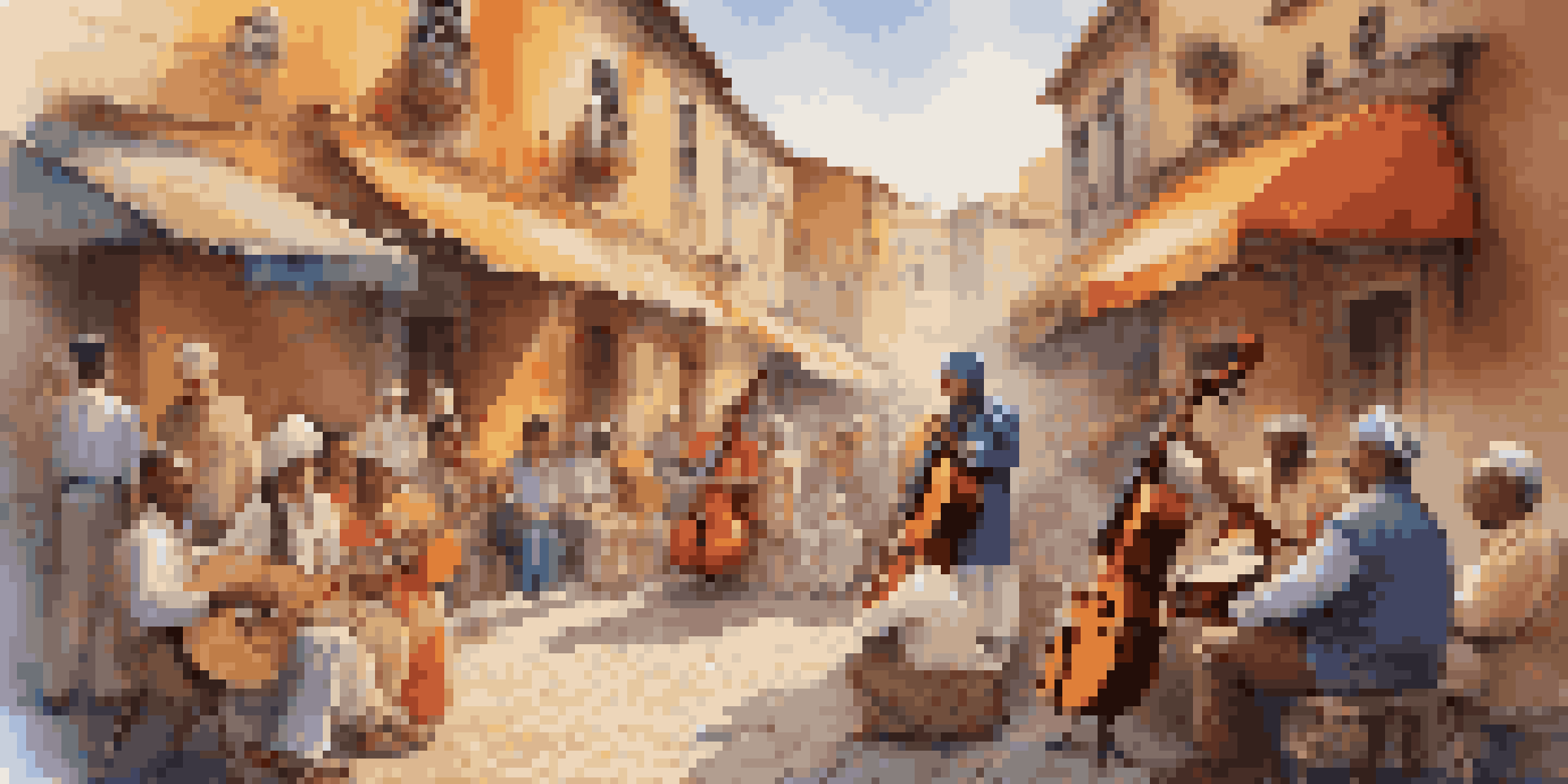The Preservation of Traditional Music in the Digital Age

The Evolution of Traditional Music in a Digital Era
Traditional music has been a cornerstone of cultural expression for centuries. With the rise of digital technology, these age-old melodies have found new platforms to reach wider audiences. This evolution enables musicians to blend traditional sounds with contemporary styles, creating a rich tapestry of musical innovation.
Music can change the world because it can change people.
For instance, artists like Yo-Yo Ma have incorporated classical music with global influences, showcasing how digital platforms expand the reach of traditional genres. Moreover, social media allows musicians to connect directly with fans, fostering a community that appreciates both the old and the new. This synergy is essential for the survival and revitalization of traditional music forms.
However, this transformation isn't without challenges. Some worry that commercialization may dilute the authenticity of traditional music, as artists adapt to market trends. Balancing respect for cultural heritage while appealing to modern tastes is crucial for the preservation of these musical traditions.
Digital Platforms: A Double-Edged Sword for Musicians
Digital platforms like Spotify and YouTube have revolutionized how we consume music. They offer unparalleled access to diverse music from around the globe, including traditional genres that might otherwise remain obscure. This accessibility empowers listeners and artists alike, creating a vibrant exchange of cultural sounds.

However, the sheer volume of content available can make it challenging for traditional music to stand out. With so many genres vying for attention, unique cultural voices may struggle to be heard. Musicians often need to harness savvy marketing strategies to ensure their traditional music reaches the right audience.
Digital Platforms Transform Music
Digital platforms have revolutionized music consumption, providing traditional artists with both opportunities and challenges in reaching wider audiences.
Additionally, the economics of streaming can be daunting for niche artists. Many traditional musicians find it difficult to monetize their work effectively on these platforms. Finding a balance between exposure and financial sustainability remains a pressing issue in the digital age.
The Role of Social Media in Music Preservation
Social media platforms have become powerful tools for preserving and promoting traditional music. Artists leverage platforms like Instagram and TikTok to share snippets of their performances, engage with audiences, and tell their cultural stories. This direct interaction fosters a sense of community and connection, vital for keeping traditional music alive.
The beauty of music is that it connects people. It doesn’t matter what language you speak, or where you are from; it speaks to the soul.
For example, viral challenges or trends can introduce traditional music to younger generations in a fun and engaging way. By blending traditional elements with popular formats, musicians can attract new fans while preserving their cultural roots. This innovative approach breathes new life into age-old songs and dances.
Moreover, social media serves as a repository for cultural documentation. Musicians and enthusiasts can share recordings, stories, and historical contexts, creating a digital archive that future generations can access. This democratization of information ensures that traditional music remains relevant and appreciated across diverse audiences.
Collaborations: Bridging Traditional and Modern Music
Collaborations between traditional musicians and contemporary artists can produce exciting, hybrid sounds. By merging genres, these partnerships not only create fresh music but also educate listeners about the roots of each style. For example, collaborations between folk and pop musicians can introduce traditional melodies to a broader audience.
These cross-genre partnerships often lead to innovative performances that resonate with diverse demographics. They allow traditional musicians to explore new avenues while maintaining their cultural essence. This blending of influences showcases the adaptability and relevance of traditional music in today's fast-paced world.
Social Media Preserves Traditions
Through social media, traditional musicians can engage with audiences, share cultural stories, and create a sense of community that helps keep their music alive.
Furthermore, such collaborations can foster cultural exchange and understanding. When modern artists incorporate traditional elements into their work, they elevate the status of these genres and create a platform for dialogue about cultural heritage. This exchange enriches both the artists and their audiences.
Education: Teaching Traditional Music in a Digital World
Incorporating traditional music into educational curricula is vital for preservation. Schools and universities are beginning to recognize the importance of teaching students about their cultural heritage through music. Digital tools can enhance this learning experience, making it interactive and engaging.
Online platforms offer resources like video tutorials, live-streamed workshops, and virtual classes. These tools enable students from various backgrounds to learn traditional instruments or songs, regardless of their geographical location. This accessibility helps keep traditional music alive by inspiring the next generation of musicians.
Moreover, educators are using social media to promote awareness and appreciation of traditional music. By sharing performances, interviews, and historical context, they create a richer learning experience. This digital approach not only preserves music but also instills pride in cultural heritage among students.
Challenges of Authenticity in a Digital Landscape
As traditional music ventures into the digital realm, concerns about authenticity arise. The ease of access to technology allows anyone to produce and share music, but this can sometimes overshadow genuine traditional practices. Maintaining authenticity while adapting to modern influences is a delicate balance for many artists.
For instance, some traditional musicians may feel pressured to conform to popular trends to gain recognition. This can lead to a dilution of their cultural roots, sparking debates about what it means to be 'authentic' in music. Understanding and respecting the heritage behind the music is crucial in navigating these challenges.
Collaborations Enrich Musical Genres
Collaborations between traditional and contemporary artists not only produce innovative sounds but also educate listeners about the cultural roots of each style.
Additionally, the digital environment can perpetuate misrepresentation. Without proper context, traditional music can be misused or appropriated, leading to a loss of cultural significance. Artists and listeners alike must advocate for respectful representation to honor the true essence of traditional music.
The Future of Traditional Music in the Digital Age
The future of traditional music in the digital age looks promising, yet complex. As technology continues to evolve, musicians will likely find new ways to engage audiences and preserve their cultural legacies. Embracing innovative tools while honoring tradition can create a vibrant musical landscape that thrives on diversity.
Moreover, the global interconnectedness facilitated by digital platforms allows traditional music to reach audiences far beyond its origins. This exposure can inspire cross-cultural collaborations and appreciation, fostering a sense of unity through music. As artists share their stories and sounds, they contribute to a larger narrative of cultural exchange.

Ultimately, the preservation of traditional music hinges on a collective effort. Artists, educators, and listeners must work together to celebrate, protect, and innovate within these musical traditions. By embracing the digital age while respecting the past, we can ensure that traditional music continues to resonate for generations to come.